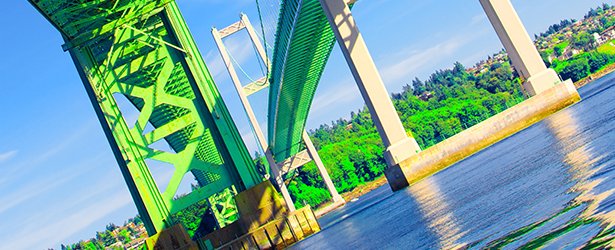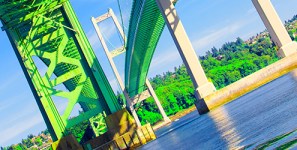top cities for global trade
CHARLOTTE, NORTH CAROLINA
Population: 827,097 | Unemployment: 4.5 percent | Project: Tryon Place, Stonewall Corridor
It’s hard to keep up with what’s going up in Charlotte, both in volume and scale. For instance, the Tryon Place project, slated for completion in 2018, will have more than 700,000 square feet of office space and 30,000 square feet of retail. The projects and energy one sees and senses in Charlotte reflect the commitment the Charlotte Chamber of Commerce has made to attracting investment, particularly from foreign sources. In 2015, the chamber landed more than $550 million in new capital investments as the number of international companies in the city jumped to 958 from 606 in 2003.
CHICAGO, ILLINOIS
Population: 2,720,546 | Unemployment: 6.2 percent | Project: Wanda Vista Tower
Vista Tower’s gaudy numbers—at 1,186 feet, it will be the city’s third tallest building when it opens in 2019—catch the eye. But it’s the Merchandise Mart, opened in 1930, where one really senses Chicago’s formidable business heat. Redevelopers have plans for six skyscrapers that would be among the 20 tallest in the city. The Mart is not only the new headquarters of ConAgra but home to business incubator 1871. Opened in 2012, it’s home to more than 350 early-stage, high-growth digital startups, venture capital firms, niche accelerators and multiple university satellite offices.
COLUMBUS, OHIO
Population: 850,106 | Unemployment: 4.2 percent | Project: Scioto Mile
In a city regularly recognized only for having a well balanced, business-friendly, diverse economy—but also making decisions with the future in mind—the Scioto Mile showcases an active greenspace developed along the Scioto Park in in the heart of Downtown Columbus. It’s a great example of the kind of public-private partnership preferred in Columbus. Not only was the project completed on budget at $44 million, but only half of that came from public funds, the rest was private. A similar arrangement was made for the ongoing upkeep of the Mile.
EL PASO, TEXAS
Population: 681,124 | Unemployment: 5.2 percent | Project: Shadow Mountain development
If there is a city that buys into redevelopment, it’s El Paso. A few years ago, voters overwhelmingly approved a $473 million bond measure that, among other things, led to the demolition of City Hall to make room for a new minor league baseball stadium (Go Chihuahuas!). The bond and the stadium have led to a building boom downtown, with an additional $38 million in the privately funded construction project that includes the 22-story, mixed-use Shadow Mountain Tower.
FORT LAUDERDALE, FLORIDA
Population: 178,590 | Unemployment: 4.1 percent | Project: The Wave Streetcar
We’re highlighting the Wave though its proposed 2.7-mile length is relatively modest because it’s emblematic of an attitude often repeated by civic leaders of creating a “city you never want to leave.” The city is booming, as the Greater Fort Lauderdale Alliance, from 2007 to 2015, has helped companies create or retain more than 22,000 direct high-value jobs, pumping nearly $10 billion into the local economy. The area south of the New River has attracted more than half a billion dollars of investment.
OPELIKA, ALABAMA
Population: 29,527 | Unemployment: 6.0 percent | Project: Northeast Opelika Industrial Park
Located adjacent to Auburn University, Opelika is developing a reputation for punching above its weight. It’s the only city in Alabama to deploy a 100 percent fiber network offering up to 1 gigabit a second Internet speeds. In the past decade, the city has announced industry investments and expansions of more than $1 billion, many in the 2,200-acre Northeast Opelika Industrial Park. Tenants include Daewon, which has invested more than $65 million, and Golden State Foods, which built a state-of-the-art meat processing facility.
RENO, NEVADA
Population: 241,445 | Unemployment: 5.5 percent | Project: Switch’s SUPERNAP expansion
In the Biggest Little City in the World, it’s pretty much Go Big or Go Home. There’s Tesla’s $5 billion gigafactory at the Tahoe Reno Industrial Center, and it’s also home to Switch’s $4 billion expansion to its Superloop, creating the largest data center campus in the world. And that’s not even mentioning Rackspace’s plans to build a $422 million, 150,000-square-foot data center or the April opening of NUANCE Lab, a joint venture between NASA and the University of Nevada, Reno, dedicated to airspace management research and a workshop for building drones and unmanned aerial systems.
SCOTTSDALE, ARIZONA
Population: 236,839 | Unemployment: 5.3 percent | Project: SkySong/ASU Scottsdale Innovation Center
With access to huge economies in California and Texas, but operating costs sometimes 40 percent lower than the neighboring Golden State, Scottsdale is able offer competitive prices for labor and space and access to more than 34 million consumers within a half-day truck haul. To take advantage, the city has energetically built itself up, with SkySong, a 1.2-million-square-foot, mixed-use project just minutes from Arizona State University that attracts a broad array of cutting-edge companies and is projected to produce $32 billion and 10,000 jobs over the next three decades.
TACOMA, WASHINGTON
Population: 207,948 | Unemployment: 6.5 percent | Project: Point Ruston
When Tacoma started remaking its downtown in the late 1990s, it gave birth to numerous multi-use projects such as Point Ruston, which attracted outsiders and kept talented Tacomans at home. The coming together of those groups in an urban landscape has created more public-private partnerships involving the University of Puget Sound, Pacific University and University of Washington, Tacoma, and its Institute of Technology. It also deepened the pool of local talent to create a rise in jobs from locally generated startups and relocated tech firms.
WASHINGTON, D.C.
Population: 672,228 | Unemployment: 6.0 percent | Project: The Parks at Walter Reed
Washington’s 672,228 residents represent a 12 percent jump since 2010—in daytime, it swells to more than 1 million—and some estimate that number will surpass 800,000 in 15 years. The city is going about remaking itself with “mixed-use” being its byword. There are at least 20 major projects in various stages of development; emblematic is The Parks, a 3.1-million-square-foot, mixed-use project located at the former Walter Reed Army Medical Center, which not only contains retail but an “Innovation Core” anchored by medical research, bioscience and pharma companies. It has attracted more than $1 billion in investments.





Leave a Reply